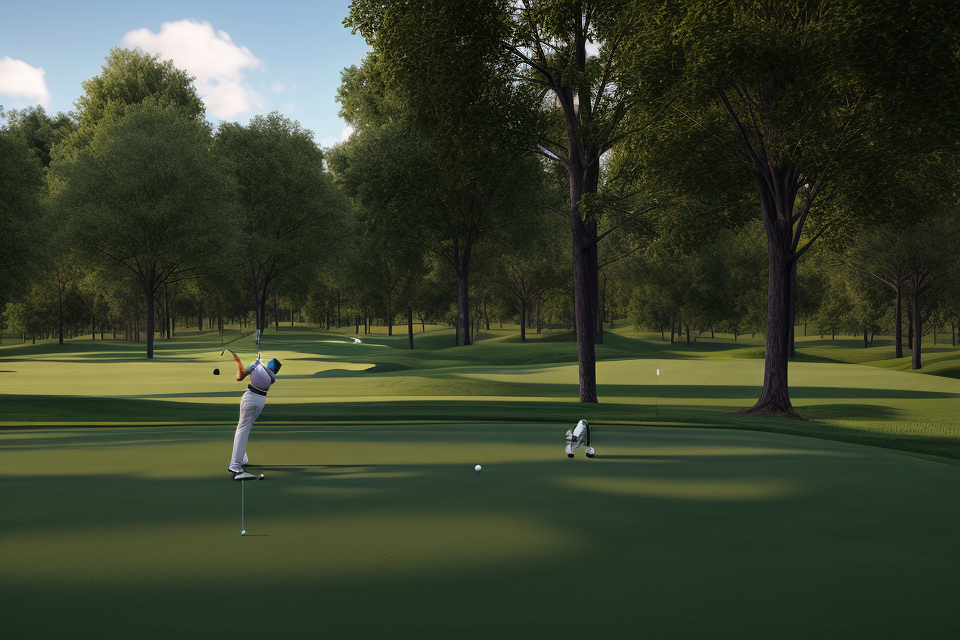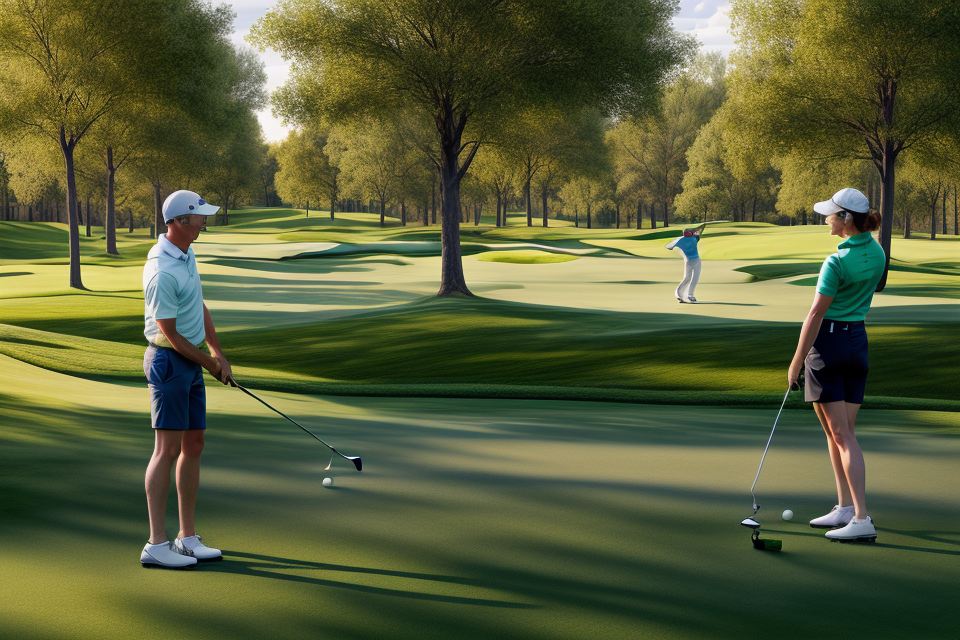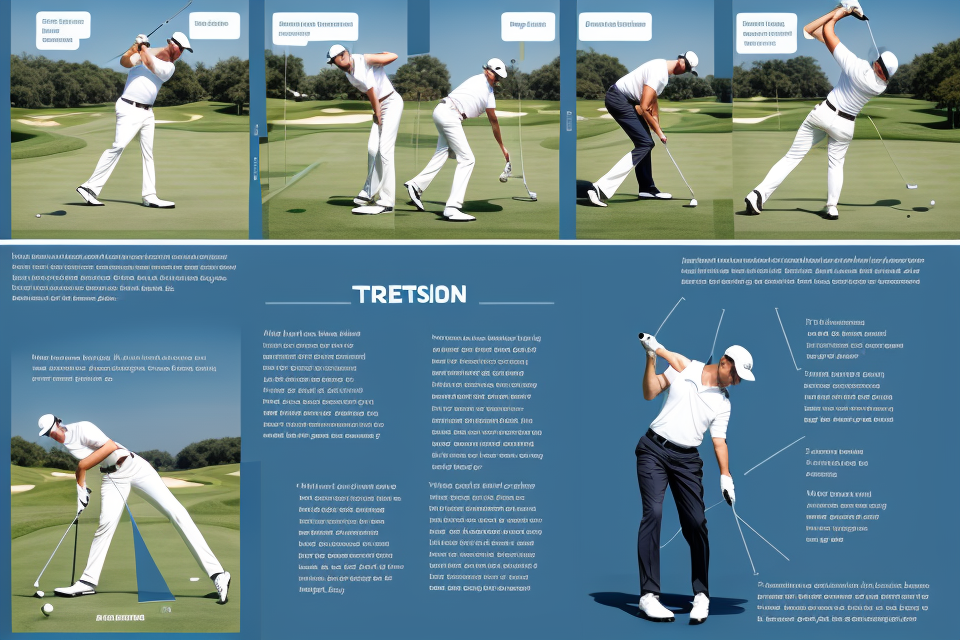
Golf is a game that requires precision, patience, and technique. While many golfers believe that swinging as hard as possible is the key to success, others argue that a more controlled and measured approach is necessary. This debate raises the question: is maximum effort always best in golf? In this article, we will explore the pros and cons of swinging for distance versus swinging for accuracy, and provide insights into how golfers can determine the best approach for their individual games. So, whether you’re a seasoned pro or a weekend warrior, read on to discover the secrets to unlocking your full golfing potential.
In golf, it is not always best to give maximum effort on every shot. While it is important to give your best effort on every shot, it is also important to conserve energy for the next shot and for the duration of the round. Additionally, putting too much effort into a shot can lead to fatigue and a loss of focus, which can negatively impact your performance. It is important to find a balance between giving maximum effort and conserving energy, in order to perform at your best throughout the entire round.
The Importance of Swing Effort in Golf
The Role of Swing Effort in Ball Speed and Accuracy
Swing effort, or the amount of force exerted during the golf swing, plays a crucial role in determining the speed and accuracy of the resulting shot. While it may seem logical that a harder, more forceful swing would produce a faster and straighter ball flight, the truth is more nuanced.
The relationship between swing effort and ball speed is complex and multifaceted. In general, a golfer’s swing speed is determined by a combination of factors, including muscle strength, coordination, and the golfer’s overall physical fitness level. While a maximum effort swing may produce more power in the short term, it can also lead to fatigue and a loss of control over the shot.
Additionally, a swing that is too aggressive or uncontrolled can lead to accuracy issues, as the golfer may struggle to maintain a consistent swing path and strike the ball with precision. In contrast, a more controlled and balanced swing, with a focus on proper technique and form, can help to ensure a more consistent and accurate shot.
In order to achieve optimal ball speed and accuracy, golfers must strike a balance between maximum effort and controlled power. This often requires a deep understanding of the mechanics of the swing, as well as a keen awareness of one’s own physical limitations and strengths. By striking this balance, golfers can optimize their swing for maximum power and accuracy, while minimizing the risk of injury or fatigue.
The Myth of “Swing Harder”
The belief that “swing harder” is the key to success in golf is a myth that has been perpetuated for many years. While it is true that golf requires physical effort, simply swinging harder is not always the best approach. In fact, attempting to swing harder can often lead to poor technique, injuries, and decreased performance.
One reason why “swing harder” is not always the best approach is that it can lead to tension and rigidity in the body. When a golfer tries to swing harder, they often tensing up their muscles in an effort to generate more power. This tension can lead to a loss of balance and control, which can negatively impact the golfer’s swing.
Additionally, swinging harder can also increase the risk of injury. Golf is a sport that requires precision and control, and swinging too hard can lead to overuse injuries such as tendinitis or golfer’s elbow. It can also increase the risk of strain or sprain, which can sideline a golfer for an extended period of time.
Furthermore, swinging harder can also lead to decreased performance. When a golfer swings too hard, they often sacrifice control and accuracy for power. This can result in shots that are hit too far to the right or left, or that are hooked or sliced. Additionally, attempting to swing harder can also lead to a loss of rhythm and timing, which can negatively impact the golfer’s overall performance.
Instead of swinging harder, golfers should focus on using proper technique and maintaining control throughout their swing. This includes keeping the body relaxed and using the muscles efficiently to generate power. By using proper technique and maintaining control, golfers can improve their accuracy and distance, while also reducing their risk of injury.
The Dangers of Over-Swinging
Increased Risk of Injury
While it is often assumed that putting forth maximum effort is the key to success in golf, there are potential dangers associated with over-swinging. One of the most significant risks is the increased likelihood of sustaining an injury.
- Swinging with maximum force can lead to overexertion, which can strain muscles and ligaments in the arms, shoulders, and back.
- Rapid and forceful movements can also increase the risk of tearing tendons or ligaments, which can result in painful and debilitating injuries.
- Over-swinging can also put undue stress on the joints, increasing the risk of developing arthritis or other joint-related conditions.
- Additionally, excessive effort can lead to fatigue, which can negatively impact a golfer’s performance and increase the risk of making mistakes on the course.
Overall, while maximum effort is important in golf, it is crucial to find a balance between giving it your all and avoiding over-exertion, as the latter can have serious consequences for both short-term and long-term performance.
Loss of Control and Accuracy
When golfers strive for maximum effort, they often focus on generating as much power as possible, leading to an increase in clubhead speed and ball velocity. However, this approach can also have detrimental effects on the golfer’s control and accuracy.
- Over-swinging can cause a loss of control over the club and the ball.
- When golfers swing too hard, they often lose their ability to make fine adjustments to their swing, leading to mishits and a loss of accuracy.
- This can be particularly problematic for golfers who are already struggling with their ball-striking, as it can exacerbate existing swing flaws and make it even more difficult to hit the ball consistently.
- Furthermore, over-swinging can also cause golfers to lose their balance and posture, which can further compromise their control and accuracy.
- By trying to swing as hard as possible, golfers may also sacrifice their accuracy for distance.
- While it’s certainly important to hit the ball far enough to reach the green or reach in regulation, it’s equally important to hit the ball accurately and avoid hazards, bunkers, and other obstacles.
- Over-swinging can lead to slicing or hooking the ball, which can cause it to deviate from its intended target and result in poor shots.
- Additionally, over-swinging can cause golfers to lose control over their ball trajectory, leading to shots that fly too high or too low, or that don’t stop on the green as intended.
- Over-swinging can also increase the risk of injury.
- Golfers who swing too hard and too fast are at a higher risk of sustaining injuries to their arms, shoulders, and back.
- Over-exertion and overuse can lead to pain, inflammation, and even long-term damage to the muscles and joints.
- Therefore, it’s important for golfers to strike a balance between power and control, and to avoid over-swinging at all costs.
The Science Behind Swing Effort
Understanding the Biomechanics of the Golf Swing
To understand the biomechanics of the golf swing, it is essential to break down the different components that make up the motion. These components include the wind-up, transition, downswing, impact, and follow-through. Each of these phases requires a specific combination of muscle activation and joint movements to achieve the optimal golf swing.
One key aspect of the biomechanics of the golf swing is the kinematic sequence. This refers to the specific order in which the body parts move during the swing. The kinematic sequence for the golf swing is:
- Swaying or moving the torso away from the target
- Beginning the downswing by shifting the weight onto the back foot
- Unwinding the body by shifting the weight back to the front foot
- Making impact with the golf ball
- Following through to the finish position
Understanding the kinematic sequence is crucial for achieving maximum efficiency and power in the golf swing. Each phase of the swing requires a specific amount of force and muscle activation to produce the desired result.
Another important aspect of the biomechanics of the golf swing is the role of the pelvis. The pelvis plays a critical role in transferring power from the lower body to the upper body during the swing. A proper pelvic movement can help increase the speed and power of the swing, while poor pelvic movement can lead to reduced power and accuracy.
Finally, the biomechanics of the golf swing also involve the use of the core muscles. The core muscles help to stabilize the body during the swing and transfer power from the lower body to the upper body. Strengthening the core muscles can help improve the overall power and control of the golf swing.
Overall, understanding the biomechanics of the golf swing is essential for achieving maximum efficiency and power in the swing. By breaking down the different components of the swing and understanding the kinematic sequence, pelvic movement, and core muscle activation, golfers can develop a more effective and powerful swing.
The Optimal Swing Effort for Different Shots
The amount of effort that a golfer should put into their swing depends on the type of shot they are attempting to make. Different shots require different levels of power and control, and thus, different levels of swing effort. For example, a golfer may need to use a maximum effort for a long drive, but a more controlled effort for a short approach shot.
Here are some factors to consider when determining the optimal swing effort for different shots:
- Distance: The further the shot, the more effort will be required to generate the necessary power.
- Wind conditions: Strong winds may require a golfer to adjust their swing effort to compensate for the wind’s impact on the ball’s trajectory.
- Terrain: Golfers may need to adjust their swing effort to account for the lie of the land, such as when hitting a shot from a slope or a bunker.
- Shot shape: The desired shot shape may also impact the amount of effort required. For example, a golfer may need to use more effort to produce a draw or a fade.
In general, golfers should aim to use the minimum amount of effort necessary to achieve their desired shot outcome. Overexertion can lead to fatigue and injuries, while under-exertion can result in a loss of power and control. Therefore, it is essential to find the right balance between power and control for each shot.
Finding the Right Balance
Balancing Swing Effort with Accuracy and Control
When it comes to golf, it’s essential to find the right balance between maximum effort and maintaining accuracy and control over your shots. Golfers who put in maximum effort during their swings often risk sacrificing precision for raw power, which can lead to poorer performance and higher scores.
In this section, we’ll explore how golfers can strike the perfect balance between maximum effort and accuracy and control.
Balancing Maximum Effort with Accuracy and Control
Maintaining Accuracy:
- Understanding the mechanics of the golf swing and the body’s movements can help golfers control their shots better.
- Focusing on maintaining a consistent and smooth swing motion can also contribute to improved accuracy.
- Practicing on various course conditions, such as windy or rainy weather, can help golfers develop the skills to adapt and maintain accuracy in different situations.
Developing Control:
- Utilizing the right equipment, such as clubs with the appropriate loft and shaft flex, can help golfers achieve better control over their shots.
- Regularly practicing short-game shots, such as chips and pitches, can improve control around the green.
- Developing a pre-shot routine can help golfers establish a consistent process for setting up and executing shots, contributing to better control over the ball’s flight.
Mastering the Balance:
- Developing a comprehensive understanding of the golf swing and the physical and mental aspects of the game can help golfers determine the appropriate level of effort for each shot.
- Utilizing video analysis and feedback from coaches or peers can provide valuable insights into areas where maximum effort may be hindering accuracy and control.
- Continuously refining and adjusting swing techniques based on experience and feedback can help golfers strike the ideal balance between maximum effort and maintaining accuracy and control.
In conclusion, striking the right balance between maximum effort and accuracy and control is crucial for golfers looking to optimize their performance. By focusing on maintaining accuracy, developing control, and mastering the balance between effort and precision, golfers can achieve a more consistent and effective swing, ultimately leading to better scores and improved overall performance.
Adapting Your Swing Effort for Different Courses and Conditions
Swinging with maximum effort may seem like the ideal approach to achieve greater distance and accuracy in golf. However, this approach is not always the best choice, especially when playing on different courses and under various weather conditions. Adapting your swing effort to suit the specific circumstances of each course can lead to better performance and more consistent results.
Here are some key factors to consider when adapting your swing effort for different courses and conditions:
- Course Design: Each golf course has its unique design features, such as elevation changes, water hazards, and bunkers. Players need to adjust their swing effort to account for these factors and avoid unnecessary risks. For example, when playing uphill or downhill shots, players may need to adjust their swing speed to maintain control and accuracy.
- Weather Conditions: Weather conditions can significantly impact the performance of golf shots. Wind, rain, and heat can affect the ball’s trajectory and distance, making it challenging to maintain accuracy. Players need to adjust their swing effort to compensate for these conditions, such as using a lower swing speed to combat strong winds or a higher swing speed to combat a wet ball.
- Personal Physical Condition: Golfers also need to consider their physical condition when adapting their swing effort. Players who are tired or experiencing physical discomfort may need to reduce their swing effort to avoid fatigue and injury. Conversely, players who are in top physical condition may be able to swing with more effort without compromising accuracy or control.
Overall, adapting your swing effort to suit the specific circumstances of each course and condition is essential for achieving optimal performance in golf. By taking into account the unique features of each course and the weather conditions, golfers can develop a more effective and consistent swing that maximizes their potential.
Maximizing Your Swing Effort Safely
Building Swing Effort Through Exercise and Drills
To safely build swing effort, it is important to incorporate exercise and drills that target the muscles used in the golf swing. Here are some examples of exercises and drills that can help improve swing power and control:
Exercises
- Resistance bands: Resistance bands can be used to target specific muscle groups, such as the shoulders, arms, and legs. They can be used to improve strength and power in these areas, which can translate to more distance and control in the golf swing.
- Weightlifting: Weightlifting exercises, such as bicep curls, tricep extensions, and squats, can help improve overall strength and power. These exercises can be done with free weights or machines and should be done with proper form to avoid injury.
- Cardiovascular exercise: Cardiovascular exercise, such as running or cycling, can help improve overall fitness and endurance. This can be beneficial for golfers who need to maintain their swing for an extended period of time.
Drills
- Driver swing: A driver swing drill involves taking a full swing with a driver, focusing on keeping the clubhead speed up and maintaining proper form. This drill can help improve swing speed and power.
- Irons swing: An irons swing drill involves taking a full swing with a iron, focusing on keeping the clubhead speed up and maintaining proper form. This drill can help improve swing speed and power.
- Wrist snap drill: A wrist snap drill involves holding a club with the hands in a neutral position and quickly snapping the wrists through impact. This drill can help improve wrist power and control.
It is important to note that these exercises and drills should be done with proper form and supervision to avoid injury. It is also important to vary the exercises and drills to prevent boredom and to ensure that all muscle groups are being targeted.
Maintaining Swing Effort Through Proper Technique and Equipment
As golfers, we all strive to achieve maximum power and distance in our swings. However, it’s important to remember that maximizing effort isn’t always the best approach. In this section, we’ll explore how proper technique and equipment can help you maintain swing effort safely and effectively.
Proper technique is crucial to maximizing power and distance in your swing without sacrificing safety. One key aspect of proper technique is the golf swing’s biomechanics. This involves using the right muscles at the right time to create a smooth, efficient swing that reduces the risk of injury.
In addition to proper technique, the right equipment can also help you maintain swing effort safely. For example, using a lighter golf club can reduce the strain on your muscles and joints, while a well-fitted golf glove can improve your grip and control.
Furthermore, incorporating flexibility and mobility exercises into your training routine can help improve your range of motion and reduce the risk of injury. These exercises can also help you maintain proper technique by ensuring that your muscles are properly warmed up and ready for action.
In conclusion, maintaining swing effort through proper technique and equipment is essential to maximizing power and distance in your golf swing without sacrificing safety. By focusing on proper technique, using the right equipment, and incorporating flexibility and mobility exercises into your training routine, you can achieve optimal performance on the golf course.
The Importance of Balancing Swing Effort with Accuracy and Control
Golf is a sport that requires precision and control, and while maximum effort can be beneficial, it is important to balance it with accuracy and control. This means that while it is essential to put in maximum effort during the swing, it is equally important to ensure that the shot is accurate and controlled.
Balancing swing effort with accuracy and control requires a deep understanding of the mechanics of the golf swing and the ability to control the movement of the body during the swing. It is important to focus on maintaining a smooth and balanced swing, rather than just putting in maximum effort.
One way to achieve this balance is by using proper technique and form. This includes maintaining a correct grip on the club, keeping the head down during the swing, and using the legs and core to generate power. By focusing on these techniques, golfers can maximize their swing effort while still maintaining accuracy and control.
Another important factor in balancing swing effort with accuracy and control is mental focus. Golfers must be able to maintain concentration and focus on the target, while also managing their swing effort. This requires a high level of mental discipline and the ability to stay focused under pressure.
In conclusion, while maximum effort can be beneficial in golf, it is important to balance it with accuracy and control. By focusing on proper technique and form, and maintaining mental focus, golfers can maximize their swing effort while still achieving accuracy and control in their shots.
The Need for Individualized Approaches to Swing Effort in Golf
- Understanding the Individuality of Golfers
Golfers, like all individuals, possess unique physical attributes, skills, and limitations. Their body types, swing mechanics, and strength levels can significantly impact their ability to generate power and control their shots. As a result, a one-size-fits-all approach to swing effort may not be suitable for all golfers. - Identifying Your Optimal Swing Effort
Determining the appropriate level of swing effort for each golfer requires a thorough understanding of their physical capabilities and swing characteristics. Factors such as body mass index, muscle imbalances, and joint mobility should be considered when assessing a golfer’s swing effort. Additionally, golfers should pay attention to their energy expenditure and fatigue levels during practice and competitive rounds to ensure they are working within their limits. - Customizing Your Swing to Maximize Effort
A well-tailored swing is crucial for maximizing effort and minimizing injury risk. Golfers should work with experienced coaches or fitness professionals to identify any flaws or weaknesses in their swing mechanics that may lead to inefficient energy use or increased risk of injury. By refining their swing technique and developing targeted conditioning programs, golfers can optimize their swing effort and enhance their overall performance. - Balancing Power and Control in Your Swing
Striking the right balance between power and control in your swing is essential for success on the golf course. While maximum effort can generate impressive distances and accuracy, overexertion can lead to fatigue, injury, and inconsistent performance. Golfers should aim to develop a swing that maximizes power without sacrificing control, focusing on efficient energy use and maintaining proper technique throughout the swing. - Embracing Individualized Approaches to Swing Effort
Golfers must recognize that their optimal swing effort may change over time due to various factors, such as age, fitness levels, or competitive demands. Continuously assessing and adjusting their swing approach based on individual needs and goals is crucial for sustained success and injury prevention. By adopting a personalized approach to swing effort, golfers can optimize their performance and enjoy a long, successful career on the golf course.
FAQs
1. Is it always best to swing as hard as you can in golf?
Answer: No, it is not always best to swing as hard as you can in golf. While it may seem like the more force you put behind your swing, the further the ball will go, this is not always the case. In fact, swinging too hard can often result in a loss of control and accuracy, leading to missed shots and higher scores.
2. What are the benefits of controlling your swing?
Answer: Controlling your swing can help you maintain better accuracy and precision, which is essential for making par and avoiding bogeys. Additionally, by controlling your swing, you can avoid injuries that may result from swinging too hard or using improper form. Finally, controlling your swing can help you avoid losing distance due to a poorly hit shot, which can be frustrating and lead to higher scores.
3. How can I control my swing in golf?
Answer: To control your swing in golf, it is important to focus on using proper form and technique. This includes keeping your arms and body in alignment during the swing, using your legs and core for power, and maintaining a smooth and steady rhythm throughout. Additionally, practicing your swing regularly and using proper equipment can help you control your swing and improve your overall performance on the course.
4. Is it okay to swing hard occasionally?
Answer: Yes, it is okay to swing hard occasionally, especially on longer shots or when trying to hit the ball farther. However, it is important to balance this with the need to maintain control and accuracy, especially when approaching the green or when attempting to hit precise shots. Additionally, swinging too hard can lead to fatigue and injury, so it is important to pace yourself and avoid overexertion.


